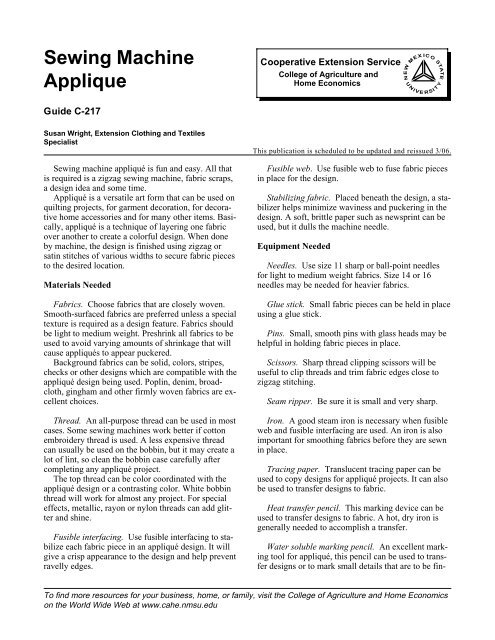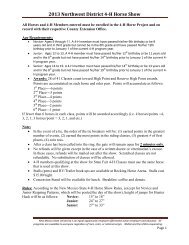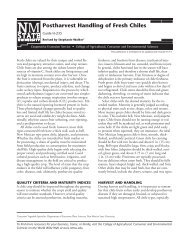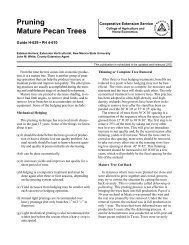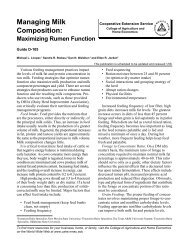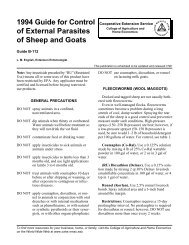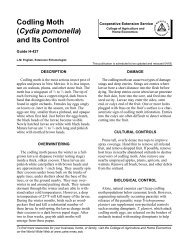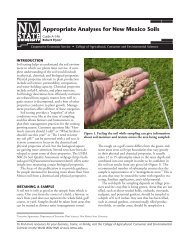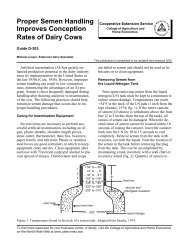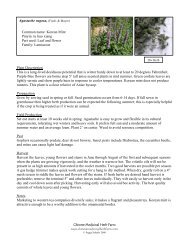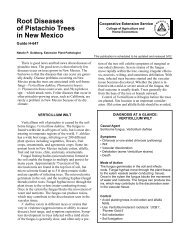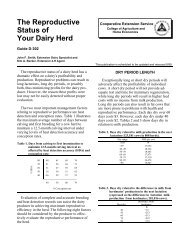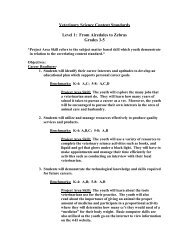Sewing Machine Applique - NMSU's College of Agriculture and ...
Sewing Machine Applique - NMSU's College of Agriculture and ...
Sewing Machine Applique - NMSU's College of Agriculture and ...
You also want an ePaper? Increase the reach of your titles
YUMPU automatically turns print PDFs into web optimized ePapers that Google loves.
<strong>Sewing</strong> <strong>Machine</strong><br />
<strong>Applique</strong><br />
Cooperative Extension Service<br />
<strong>College</strong> <strong>of</strong> <strong>Agriculture</strong> <strong>and</strong><br />
Home Economics<br />
N EW MEX<br />
U N<br />
ICO<br />
STA<br />
E<br />
I V E R SI T Y<br />
T<br />
Guide C-217<br />
Susan Wright, Extension Clothing <strong>and</strong> Textiles<br />
Specialist<br />
<strong>Sewing</strong> machine appliqué is fun <strong>and</strong> easy. All that<br />
is required is a zigzag sewing machine, fabric scraps,<br />
a design idea <strong>and</strong> some time.<br />
Appliqué is a versatile art form that can be used on<br />
quilting projects, for garment decoration, for decorative<br />
home accessories <strong>and</strong> for many other items. Basically,<br />
appliqué is a technique <strong>of</strong> layering one fabric<br />
over another to create a colorful design. When done<br />
by machine, the design is finished using zigzag or<br />
satin stitches <strong>of</strong> various widths to secure fabric pieces<br />
to the desired location.<br />
Materials Needed<br />
Fabrics. Choose fabrics that are closely woven.<br />
Smooth-surfaced fabrics are preferred unless a special<br />
texture is required as a design feature. Fabrics should<br />
be light to medium weight. Preshrink all fabrics to be<br />
used to avoid varying amounts <strong>of</strong> shrinkage that will<br />
cause appliqués to appear puckered.<br />
Background fabrics can be solid, colors, stripes,<br />
checks or other designs which are compatible with the<br />
appliqué design being used. Poplin, denim, broadcloth,<br />
gingham <strong>and</strong> other firmly woven fabrics are excellent<br />
choices.<br />
Thread. An all-purpose thread can be used in most<br />
cases. Some sewing machines work better if cotton<br />
embroidery thread is used. A less expensive thread<br />
can usually be used on the bobbin, but it may create a<br />
lot <strong>of</strong> lint, so clean the bobbin case carefully after<br />
completing any appliqué project.<br />
The top thread can be color coordinated with the<br />
appliqué design or a contrasting color. White bobbin<br />
thread will work for almost any project. For special<br />
effects, metallic, rayon or nylon threads can add glitter<br />
<strong>and</strong> shine.<br />
Fusible interfacing. Use fusible interfacing to stabilize<br />
each fabric piece in an appliqué design. It will<br />
give a crisp appearance to the design <strong>and</strong> help prevent<br />
ravelly edges.<br />
This publication is scheduled to be updated <strong>and</strong> reissued 3/06.<br />
Fusible web. Use fusible web to fuse fabric pieces<br />
in place for the design.<br />
Stabilizing fabric. Placed beneath the design, a stabilizer<br />
helps minimize waviness <strong>and</strong> puckering in the<br />
design. A s<strong>of</strong>t, brittle paper such as newsprint can be<br />
used, but it dulls the machine needle.<br />
Equipment Needed<br />
Needles. Use size 11 sharp or ball-point needles<br />
for light to medium weight fabrics. Size 14 or 16<br />
needles may be needed for heavier fabrics.<br />
Glue stick. Small fabric pieces can be held in place<br />
using a glue stick.<br />
Pins. Small, smooth pins with glass heads may be<br />
helpful in holding fabric pieces in place.<br />
Scissors. Sharp thread clipping scissors will be<br />
useful to clip threads <strong>and</strong> trim fabric edges close to<br />
zigzag stitching.<br />
Seam ripper. Be sure it is small <strong>and</strong> very sharp.<br />
Iron. A good steam iron is necessary when fusible<br />
web <strong>and</strong> fusible interfacing are used. An iron is also<br />
important for smoothing fabrics before they are sewn<br />
in place.<br />
Tracing paper. Translucent tracing paper can be<br />
used to copy designs for appliqué projects. It can also<br />
be used to transfer designs to fabric.<br />
Heat transfer pencil. This marking device can be<br />
used to transfer designs to fabric. A hot, dry iron is<br />
generally needed to accomplish a transfer.<br />
Water soluble marking pencil. An excellent marking<br />
tool for appliqué, this pencil can be used to transfer<br />
designs or to mark small details that are to be fin-<br />
To find more resources for your business, home, or family, visit the <strong>College</strong> <strong>of</strong> <strong>Agriculture</strong> <strong>and</strong> Home Economics<br />
on the World Wide Web at www.cahe.nmsu.edu
ished by h<strong>and</strong>. It is useful in situations when a heat<br />
transfer pencil cannot be used.<br />
Fray retardant. This special sewing aid prevents<br />
fraying <strong>of</strong> fabric edges <strong>and</strong> is especially useful when<br />
loosely woven fabrics are used.<br />
Press cloth. A press cloth is important to prevent<br />
vent getting a shine on fabrics. It will also protect the<br />
iron from coming into direct contact with fusible web.<br />
Setting Up Your <strong>Machine</strong><br />
A neat zigzag or satin stitch is used to finish the<br />
raw edges <strong>of</strong> a sewing machine appliqué design. To<br />
achieve a good looking zigzag stitch, your machine<br />
must be carefully adjusted.<br />
The width <strong>of</strong> the zigzag stitch used will be determined<br />
by the size <strong>of</strong> the design <strong>and</strong> the type <strong>of</strong> fabric<br />
being stitched. Smaller designs will require a narrow<br />
row <strong>of</strong> zigzag stitching. Larger designs can be finished<br />
with wider zigzag stitching. Firmly woven fabrics<br />
can be finished with a narrower row <strong>of</strong> zigzag<br />
stitching than loosely woven fabrics.<br />
The stitch length or closeness <strong>of</strong> stitches should be<br />
adjusted so the stitches form a smooth line <strong>of</strong> satin<br />
stitches. If the stitch length is too long, fabric edges<br />
will ravel out from between stitches. If the stitch<br />
length is too short, the stitches will bunch up <strong>and</strong><br />
cause the machine to jam.<br />
Read the sewing machine manual to determine the<br />
exact machine settings required for appliqué work.<br />
The booklet will also give the position <strong>of</strong> the feed<br />
dogs <strong>and</strong> tell whether or not a presser foot must be<br />
used.<br />
An adjustment <strong>of</strong> top thread tension may be suggested<br />
for some machines. Loosening the top tension<br />
will allow stitches to interlock on the wrong side <strong>of</strong><br />
the fabric. Some machines have a bobbin adjustment<br />
that creates a smooth satin stitch.<br />
Do a line <strong>of</strong> test stitching to be sure the top thread<br />
<strong>and</strong> bobbin thread are interlocking securely. The top<br />
thread should appear as a narrow row <strong>of</strong> color on each<br />
side <strong>of</strong> the bobbin thread. If the bobbin thread appears<br />
as a straight line <strong>of</strong> stitching, the top tension is too<br />
loose <strong>and</strong> needs to be tightened.<br />
Preparing the Design<br />
Designs for sewing machine appliqué can range<br />
from simple to complex. The fewer pieces, the simpler<br />
the design will be. Designs can be taken from a<br />
variety <strong>of</strong> sources. One popular source is children’s<br />
coloring books. These designs are usually simple <strong>and</strong><br />
relatively large.<br />
To prepare the design, trace it on tracing paper or<br />
on a stabilizing fabric. If the design is to be transferred<br />
to fabric, it can be retraced on the wrong side<br />
<strong>of</strong> the tracing paper with a heat transfer pencil. The<br />
design can be transferred to the right or wrong side <strong>of</strong><br />
the background fabric, depending on the appliqué<br />
technique being used.<br />
If the design has a direction or if letters or numbers<br />
are involved, be sure they will be correctly placed<br />
when the design is transferred.<br />
Using Fusible Interfacing<br />
To create a crisp design, stabilize each piece <strong>of</strong> fabric<br />
used in an appliqué design with fusible interfacing.<br />
Place swatches <strong>of</strong> fabric to be used over a piece <strong>of</strong><br />
fusible interfacing <strong>and</strong> fuse. Then transfer the design<br />
shapes to the fabric <strong>and</strong> cut out.<br />
In some cases, you may cut out all the fabric pieces<br />
<strong>of</strong> an appliqué design <strong>and</strong> arrange them on a single<br />
piece <strong>of</strong> fusible interfacing before fusing them.<br />
In either case, fusible interfacing gives the appliqué<br />
design a crisp look <strong>and</strong> helps prevent ravelly edges.<br />
Traditional Appliqué<br />
Step 1. Transfer the appliqué design to the right<br />
side <strong>of</strong> the background fabric.<br />
Step 2. Cut design pieces from desired fabrics. Be<br />
sure to cut pieces on straight grain whenever possible.<br />
Step 3. Cut out fusible web in the shape <strong>of</strong> the<br />
complete design. Position where design is to be placed.<br />
Hold steam iron over fusible web for a few seconds<br />
<strong>and</strong> press gently with finger tips around edges to<br />
anchor it in place.<br />
Step 4. Locate fabric pieces <strong>of</strong> design over fusible<br />
web. Touch center <strong>of</strong> each piece with tip <strong>of</strong> iron for a<br />
few seconds to anchor in place.<br />
Step 5. When all pieces are securely in place, cover<br />
with a press cloth <strong>and</strong> press to fuse pieces. Follow the<br />
instructions on fusible web carefully.<br />
Step 6. Put a piece <strong>of</strong> stabilizer behind the design.<br />
Step 7. Zigzag around each piece to secure it<br />
in place.<br />
Step 8. Remove stabilizer fabric.<br />
Guide C-217 • Page 2
Reverse Appliqué<br />
Step 1. Transfer design to stabilizing fabric.<br />
Step 2. Secure stabilizing fabric to the wrong side<br />
<strong>of</strong> the background fabric.<br />
Step 5. From wrong side, sew a row <strong>of</strong> small open<br />
zigzag stitching around edges that will not be overlapped<br />
by any other layers <strong>of</strong> fabric. Straight stitch the<br />
edges that will he overlapped.<br />
Step 6. Turn to right side <strong>of</strong> design <strong>and</strong> trim <strong>of</strong>f excess<br />
fabric.<br />
Step 3. Determine the order in which fabrics<br />
should be placed on the design. Mark sections <strong>of</strong> design<br />
<strong>and</strong> the fabrics 1, 2, 3 - in the order corresponding<br />
to how they will be sewn in place.<br />
Step 7. Sew a closer, wider zigzag over first row <strong>of</strong><br />
stitching to finish the edges.<br />
Step 4. Cut squares <strong>of</strong> fabric slightly larger than<br />
the areas they are to cover. Pin each one in place with<br />
wrong side against right side <strong>of</strong> background fabric.<br />
Pin from side on which the design is traced. Pin fabric<br />
1 in place, be sure fabric is placed on straight grain.<br />
Step 8. Repeat steps 5—7 until all pieces are in<br />
place <strong>and</strong> design is completed.<br />
Special Tips<br />
At beginning <strong>of</strong> each line <strong>of</strong> stitching, backstitch 5<br />
or 6 straight stitches to lock threads in place before<br />
zigzagging.<br />
At end <strong>of</strong> each line <strong>of</strong> stitching, sew 5 or 6 straight<br />
stitches along edge <strong>of</strong> row <strong>of</strong> zigzag stitching to lock<br />
threads in place.<br />
Guide C-217 • Page 3
If fabrics are especially loosely woven, back the<br />
fabric with a fusible interfacing before cutting fabric<br />
pieces.<br />
When turning corners, leave the needle down in the<br />
fabric on the outside edge <strong>of</strong> the design. Then raise<br />
the presser foot <strong>and</strong> pivot the fabric as needed. Lower<br />
the presser foot <strong>and</strong> begin stitching so stitches overlap<br />
neatly on the corners.<br />
When stitching hold the first two fingers <strong>of</strong> your<br />
left h<strong>and</strong> on both sides <strong>of</strong> the presser foot in a V-<br />
shape to keep fabric taut. This will prevent the fabric<br />
from forming a tunnel inside the stitches.<br />
New Mexico State University is an equal opportunity/affirmative action employer <strong>and</strong> educator. NMSU <strong>and</strong> the U.S. Department <strong>of</strong><br />
<strong>Agriculture</strong> cooperating.<br />
Reprinted March 2001<br />
Guide C-217 • Page 4<br />
Las Cruces, NM<br />
5C


